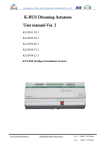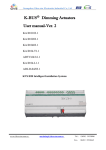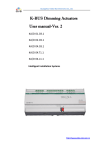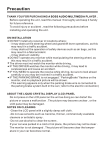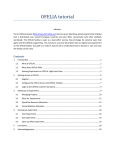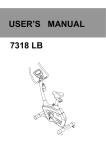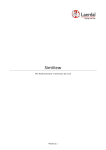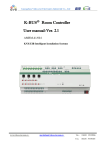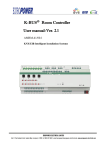Download KNX Dimmer Module User manual-Ver. 1
Transcript
KNX Dimmer Module User manual-Ver. 1 VKAD 0103 VKAD 0203 VKAD 0403 KNX Dimmer Module User Manual Content 1. 2. 3. 4. 5. 6. 7. Introduction ................................................................................................................... 3 Technical Parameter .................................................................................................... 3 Dimension and Connection Diagram ...................................................................... 5 3.1 KA/D0103.1 ............................................................................................................... 5 3.2 KA/D0203.1 ............................................................................................................... 7 3.3 KA/D0403.1 ............................................................................................................... 8 3.4 Load Type ................................................................................................................. 9 Dimming operation mode ......................................................................................... 10 Programming Introduction ...................................................................................... 10 5.1 Switch ...................................................................................................................... 10 5.2 Relative dimming .................................................................................................. 10 5.3 Absolute dimming ................................................................................................ 11 5.4 Status Report ......................................................................................................... 11 5.5 Scene ....................................................................................................................... 12 5.6 Preset Value ........................................................................................................... 12 5.7 Staircase Lighting Function ............................................................................... 12 5.8 Reset ........................................................................................................................ 13 5.9 Error Report ........................................................................................................... 13 5.10 Normal operation signs ................................................................................. 13 Parameters Setup Description ................................................................................ 13 6.1 Introduction ............................................................................................................ 13 6.1.1 Normal Dimming ................................................................................... 13 6.1.2 Staircase Lighting ................................................................................. 14 6.2 Parameter Window “Device general” .............................................................. 14 6.3 Parameter Window “CH X active” .................................................................... 15 6.4 Parameter Window “CHX general” .................................................................. 17 6.5 Parameter Window: dimming general ............................................................. 18 6.5.1 Setting of “CH X dimming general” ................................................. 18 6.5.2 Parameter Window “X: dimming” .................................................... 21 6.5.3 Parameter Window “X: scene page” ............................................... 24 6.5.4 Parameter Window “X: preset” ......................................................... 26 6.6 Staircase Lighting Mode ..................................................................................... 28 Communication Object Description ...................................................................... 30 7.1 Communication object of “Device General” ................................................. 30 7.2 General communication object of “Dimming Actuator” ............................. 31 7.3 Scene function communication object of “Dimming Actuator” ............... 32 7.4 Preset value function communication object “Dimming Actuator” ........ 32 7.5 Staircase Lighting Function communication object of “Dimming Actuator” .............................................................................................................................. 33 Vity Technology www.vity.com KNX Dimmer Module User Manual 1. Introduction The dimmer is a device dimming the luminaries directly by the data in the memory, and the data is processed in advance in the programming software according to the distribution characteristics of the luminaries’ brightness. The controller transfers the brightness data value to output voltage to control the brightness of the luminaries; Our dimmers have 3 categories: 1-channel, 2-channel and 4-channel. It is able to dim one independent group of luminary by 1-channel dimmer, 2 independent groups of luminaries by 2-channel dimmer, and 4 independent groups of luminaries by 4-channel dimmer, Dimmer is also equipment which is installed in the distribution box or distribution board and connected to the EIB BUS. It can be programmed; it can be use to customize the rooms’ environment to build the various scenes, such as WATCH MOVIE, ENTERTAMENT, DINNER and REST and so on; it’s brightness value can be set as any value (1-100%); it is able to set the duration time to dim up or down to the target brightness value and the gradual change speed to extend the luminaries life and save energy and so on. 2. Technical Parameter Power Supply: Operating voltage 21~30VDC, made available by the EIB-BUS Input Voltage: 230VAC (50/60Hz) Dimming Output: VKAD 0103----1 channel VKAD 0203----2 channels VKAD 0403----4 channels KA/D Type: 01.03.1 / 02.03.1 / 04.03.1 Output Voltage: 230 V AC (50/60Hz) Max. Output Capacity: VKAD 0103, 500W per out output VKAD 0203, 500W per out output VKAD 0403, 400W per out output Max. Leakage Loss: 5W BUS Connection: 1 KNX/EIB BUS connection terminal Load Circuits: 2 connection terminals per output Vity Technology www.vity.com KNX Dimmer Module User Manual Cable Cross-section: single core 0.2~4.0mm2 multi core 0.2~2.5 mm2 Operation Display: LED and push button for assigning the physical address IP Grade: IP 20, EN 60 529 Temperature Range: Operation -5°C~45°C Storage -25°C~55°C Transport -25°C~70°C Housing and Color: Plastic, white Mounting: Standard 35mm DIN RAIL installation Dimension: VKAD 0103----71.5 x 90 × 60mm (H×W×D) VKAD 0203----143 x 90 × 60mm (H×W×D) VKAD 0403----214.5 x 90 × 60mm (H×W×D) Weight: 0.25KG/ KG/ KG CE norm: In accordance with the EMC guideline and the low voltage guideline EN50090/EN60669 Vity Technology www.vity.com KNX Dimmer Module User Manual 3. Dimension and Connection Diagram 3.1 VKAD 0103 ◆ Dimension drawing: Vity Technology www.vity.com ◆ KNX Dimmer Module User Manual Connection Diagram: Vity Technology www.vity.com KNX Dimmer Module User Manual 3.2 VKAD 0203 ◆ Dimension drawing: ◆ Connection Diagram: Vity Technology www.vity.com KNX Dimmer Module User Manual 3.3 VKAD 0403 ◆ Dimension drawing: ◆ Connection Diagram: Note: it is not allowable to program all these above devices if there is no authorized software (ETS 3 or later) to be installed in the PC. Vity Technology www.vity.com KNX Dimmer Module User Manual 3.4 Load Type ◆ Resistive loads: ◆ Capacitive loads: ◆ Inducive loads: Note: it is however not permitted to connect inductive and capacitive loads together at the same output, but connect resistive loads with one of both. Vity Technology www.vity.com KNX Dimmer Module User Manual 4. Dimming operation mode The dimmer adopts the lagging edge dimming mode. Explanation of the dimming system: dimmer will be on at the zero-crossing point, seen below Figure. During this moment, the voltage is very low, and there is no current impact to the load, which is able to not only extend the lamp life, but also create no interfere to the power grid. 5. Application Programming Introduction It is able to set different parameters to every output channel, and control various targets by modifying the setup of the internal parameters. 5.1 Switch The output can be switched ON or OFF by 1 bit data. It is able to set the brightness value as the last one or a defined one (1%-100%) when switching on the luminaries. It is able to set a delay time (changing time) to dim UP the luminaries or dim UP gradually in the default period. When receiving the OFF message, the dimmer will be switched off immediately, or dim DOWN gradually after a delay time (changing time) or in the default changing period. 5.2 Relative dimming 4 data bits control: the relative dimming command means it is possible to dim UP or DOWN to the needed brightness value during the set brightness threshold range. It is only valid to dim UP when the brightness value is smaller than the low threshold value and dim DOWN when the brightness value is greater than the high threshold value. It is also able Vity Technology www.vity.com KNX Dimmer Module User Manual to set whether to switch on the luminaries by the message “dim UP to a certain value” when the output is 0 by this function. The relative dimming is used to control the relative changes of the brightness by 4 data bits: the lowest 3 bits are controlling-bit and the highest bit is----- “1” means dim UP, “0” means dim DOWN. Explanation of setting relative dimming: (1-7: dim DOWN; 0-8 remain unchanged (stop dimming); 9-15 dim UP) Parameter value Dim DOWN 0 Unchange/stop 1 255 2 28 3 64 4 32 5 16 6 8 7 4 dimming Down Parameter value Dim UP 8 Unchange/stop 9 255 10 128 11 64 12 32 13 16 14 8 15 4 dimming UP 5.3 Absolute dimming 8 data bits control: it is able to dim to the needed brightness value by changing the brightness parameters. The setting of the parameters is similar as relative dimming with the brightness value range: one low threshold value and one high threshold value. And it is not allowed to change the brightness value beyond the set range, the max. range is from 0 to 255. This function offers the possibility to dim UP or DOWN to 0 gradually to the target value by setting the delay time or the default time. The high and low threshold value limits the total output of the dimmer; any brightness value beyond the range is not valid. When the output is 0, it is able to set switching off the luminaries or remaining to a lower brightness value; and also in this status it is optional to switch on the luminaries by receiving the message “absolute dimming”. 5.4 Status Report 1 data bit: the dimmer offers the possibility whether sending the latest brightness value report of the controlled target and the changed report of the switch status to the BUS. Vity Technology www.vity.com KNX Dimmer Module User Manual 5.5Scene 8 data bits control: the dimmer offers 16 (0-15) scenes for selection. The default value of SCENE 0 is 0, and it is possible to set the others’ value to build the needed scene. It is possible to set ONE brightness value and the gradual change time of ON for each scene. After setting, it is easy to call any favorite scene. 1 in the highest bit of the scene command it means “saving” command, to save the current brightness value to the relevant scene. 5.6Preset Value The dimmer can preset scene, the object directly through 1bit data to transfer the preset scene or through 1bit data to let favorite scene to replace original preset scene. There are two preset values per output, there are two brightness values can be transfer for each preset value. Such as in theater, we need a relatively bright lighting effect when coming in, we can through transfer the first brightness value to be achieved this effect, when the movie starts playing, we need a relatively dark lighting effect, we can through transfer the second brightness value to be achieved. We can return to the previous brightness value when the movie ended. 5.7Staircase Lighting Function The dimmer offers the function of staircase lighting control besides the normal lighting control. The staircase lighting function serves to switch off the lighting directly until dimming DOWN to 20% of the brightness value after a set period. It is able to set the brightness of the luminaries, the duration of the light ON, the time to dim down to 20% separately. In this function, it uses 1 data bit control the targets directly by setting a permanent fixed value to the output of the staircase luminaries. The steps of staircase lighting control: the staircase luminaries will be switched on for a certain time (this time can be set) if the controlled target receives the message of “1”; these luminaries will be switched on again when receiving another message “1” during this period. The luminaries will be switched off when they are dimmed down to 20% of the brightness value (the dim down time can be set) after this period, or switch off the luminaries by sending message “0” to the controlled target. The luminaries will be off after dimming down to 20% when receiving the message “0” (the same dimming down time as above). When enabling the function “On receiption switch OBJ=0 switch off”, it is able to use the function "switch off" to turn off the output in the status of "permanent on", or change the status from "switch on" to "permanent on" (message “1” means ON, “0” means OFF). Vity Technology www.vity.com KNX Dimmer Module User Manual 5.8Reset When the BUS is power off, all the outputs are switched off; the current brightness value will be saved to the memory of the dimmer. When the BUS voltage is recovered, the brightness status may be the last brightness value, or the preset brightness value. When the BUS is power off, it may have the following situation occurring: In the normal mode, 2 optional behaviors after the BUS voltage recovery are: the last brightness value before power off, or the set value. In the staircase lighting mode, the behavior after the BUS voltage recovery is: ON or OFF. No output when it is OFF; start the behavior “switch=1” when it is ON. 5.9Error Report The dimmer offers the possibility of reporting the error status of the system; the data type is 1 byte: Data bit Target Function Bit0 CH 1 Short circuit, Bit1 CH 2 Short circuit, Bit2 CH 3 Short circuit, Bit3 CH 4 Short circuit, Bit4 The heat sink is over over load over load over load over load temperature 5.10 Normal operation signs 1 bit data. The sign will be report periodically to the Bus when the dimmer is working normally. 6. Parameters Setup Description 6.1 Introduction 2 operation modes (main function) per output: 6.1.1 Normal Dimming This mode is mainly used to control the normal luminaries system, which can set the output time and the brightness value of the dimmer, dim UP or DOWN with the function of “relative dimming”, and also call the set brightness values from the scene function, until dim to the required environment. Vity Technology www.vity.com 6.1.2 KNX Dimmer Module User Manual Staircase Lighting The mode is mainly used to control the staircase luminaries. Switch ON the staircase luminaries and switch OFF automatically after a certain period, or switch OFF by manually. 6.2 Parameter Window “Device general” Fig. 6.1 Parameter window “Device general” “Telegram rate” This command is used to set the frame speed. Options: No limit Delay 100ms Delay 200ms …… Delay 700ms In this system the function of frame speed is unavailable. Vity Technology www.vity.com KNX Dimmer Module User Manual “Error report” This parameter defines the error report status of the system, controlled by 1 byte data bit. Options: Disable Enable There is an error report after the malfunction in the system when selecting “enable”, otherwise, there is no report when selecting “disable”. It will send an alarm to switch off the device if with over temperature, overload or short circuit. “Sending cycle time in s[1…65535]” This parameter defines the time interval that the dimmers send the error report by the bus, which will be started when enabling the error report. Options: 1…..65535s “Send object “in operation” This command is used to send messages “1” or “0” to the BUS periodically to check the device whether is working or not. Options: No Send value “0” cyclically Send value “1” cyclically It will not send any telegram with “No”; and show the following parameters with “Send value ‘0’ cyclically” or “Send value '1' cyclically” to define the time interval of sending telegram. Sending cycle time in s[1...65535] This parameter defines the time interval of the telegram to report the normal working condition of the dimmer. Options: 1...65535s 6.3 Parameter Window “CH X active” The parameter window of “CH X active” can be seen in Fig. 6.2, which activate or deactivate the output of Channel X. The “CH X” or “X” in the following text means any one output of the dimmers. The functions are describes as below and all the channels have them same functions setup. Vity Technology www.vity.com KNX Dimmer Module User Manual Fig. 6.2 Parameter window “CH X active” “CH X active” Options: Actived Deactive The window shown in Fig. 6.3 will pop out when choosing “Actived”. In this window, it is able to set the working mode, the current brightness status and the switch status report. It will become null with “Deacitved” selection. Vity Technology www.vity.com KNX Dimmer Module User Manual 6.4 Parameter Window “CHX general” Fig. 6.3 Parameter window “CH X general” “Staircase lighting” Options: Actived Deactive It is in the status of staircase lighting control with “Actived” and in the normal dimming control with “Deactive”. “Brightness value OBJ transmit after dimming” This function is used to report the latest brightness value. When enable this function, it will send a frame to the BUS no matter what happen to make the brightness value changed. Options: Nothing Transmit new brightness Vity Technology www.vity.com KNX Dimmer Module User Manual It will not send any report of the current brightness value with “Nothing”. And send a frame to the BUS to report the current brightness value no matter what happens to make the brightness value changed with “Transmit new brightness”. “Status report” This function defines whether report the switch status to the BUS when the setup object “switch” is changed. Send “1” to the BUS when the current brightness value is greater than 0; send “0” when the value is equal to 0. Options: Nothing It’s new status It will not send any report of the current switch status with “Nothing”. And send a status changed report of switch to the BUS with “It’s new status”. 6.5 Parameter Window: dimming general 6.5.1 Setting of “CH X dimming general” Fig. 6.4 Parameter window “CH X dimming general” Vity Technology www.vity.com KNX Dimmer Module User Manual “Time duration of dimming time=entry*2” It is used to set the dimming time duration. No matter it is brightness dimming or switch dimming, when choosing the dimming time duration for dimming on or dimming off, the time is equal to this input value multiply 2 seconds, and the maximum input time is 255s. “Switch on via OBJ “switch” with” It is used to select the brightness value is the last one or the preset one when using the switch mode to switch on the luminaries. Options: Preset brightness value Last brightness value The option “Preset brightness value” means the brightness value is the preset value when switching on the luminaries by switch mode. When the brightness low threshold value is greater than the switch preset value, the brightness value of the luminaries is the low threshold value after switching on; when the switch preset value is greater than the high threshold, the brightness value is the high threshold one after switching on. The high and low threshold of the brightness are shown in the parameter window “CH X dimming”, see Fig. 6.5. The option “Last brightness value” means the brightness value is the last status’ value which is not equal to 0. If the behavior of switching on the luminaries in switch mode after the BUS reset, and the luminaries during BUS reset are off, so the brightness value is the default brightness value 128; Other cases, the brightness value is the last status’ value which is not equal to 0 on switching mode. “Preset switch on brightness(1%~100%)” It is used to set the brightness value when switch on the luminaries in switch mode, with the setting range 1%~100%. “Reaction on receipt of switch on value” It shows the time duration to switch on the luminaries in switch mode. Options: Dimming on Switch on softly Vity Technology www.vity.com KNX Dimmer Module User Manual The option “Dimming on” means the switch dimming time is the input time multiplies 2. Then option “Switch softly” means the default dimming time is 4s. “Reaction on receipt brightness value” It is used to set the brightness value in the brightness dimming mode. Options: Dimming on Switch on softly The option “Dimming on” means the brightness dimming time is the input time multiplies 2. Then option “switch softly” means the default dimming time is 4s. “Switch-off mode” It shows the time duration to switch off the luminaries in switch dimming mode. Options: Dimming off Switch off softly Switch off instantly The option “Dimming off” means the switch dimming time is the input time multiplies 2. The option “switch softly” means the default dimming time is 4s. The option “switch off instantly” means the luminaries are switch off immediately. “After bus recover switch on with” It means in the normal situation, the behavior after the BUS reset is the brightness value before power off or the preset value. Options: Preset brightness value Last brightness value The option “Preset brightness value” means the brightness value after the BUS power recovers is the input preset brightness value in the “bus recover preset brightness value (0%~100%)”. If the input preset value is smaller than the low threshold, the value after the BUS power recovery is the low threshold; if the preset input value is greater than the high threshold, the value after the BUS power recovery is the high threshold. The high and low threshold are shown in the parameter window “CH X dimming”, see Fig. 6.5. The option “Last brightness value” means the brightness value is the last value before power off after BUS power recovery. It also carry out a bus reset operation after downloading the parameters. Vity Technology www.vity.com KNX Dimmer Module User Manual “Bus recover preset brightness value(0%~100%)” It is used to set the brightness value during the BUS power recovery, and the range is 0%~100%. “Status report after telegram to obj “switch”” It is a backup parameter. 6.5.2 Parameter Window “X: dimming” Fig. 6.5 Parameter window “X: dimming” This window is used to set the parameters in the brightness dimming mode. There are 2 type of brightness dimming mode: Relative dimming and Brightness value: 6.5.2.1 Relative Dimming “low dimming threshold 1~127(0.4%~49.9%)” This parameter defines the low threshold value of the relative dimming. When it is smaller than the low threshold, it is not allowed to dim DOWN, only to dim UP, the range is 1~127 (0.4%~49.9%). Supposing the low threshold is 50, if the current brightness value is smaller than 50, so it is not allowable to dim DOWN until dimming UP to above 50. Vity Technology www.vity.com KNX Dimmer Module User Manual “upper dimming threshold 128~255(50.2%~100%)” This parameter defines the high threshold value of the relative dimming. When it is greater than the high threshold, it is not allowed to dim UP, only to dim DOWN, the range is 128~255 (50.2%~100%). Supposing the high threshold is 200, if the current brightness value is greater than 200, it is not allowable to dim UP until dim DOWN to below than 200. “If dimming down and value <=low dimming threhold output switch” This parameter defines the action after relative dimming, whether it will be off or stay in the low threshold value. Options: Off To low threshold value Supposing the low threshold is 50. If it is “Off”, it will switch off the luminaries when dim DOWN to 50; if it is “To low threshold value”, the value of the luminaries will remain the same even when dimming DOWN to 50. However, no matter whether it is “Off” or “To low threshold value”, if the low threshold of the relative dimming is smaller than that of the brightness, it will switch off the luminaries automatically when dimming DOWN to the low threshold of the brightness value; if the high threshold of the brightness is greater than relative high threshold, it is only possible to dim UP to the high threshold of the brightness. (The high and low threshold value will limit the total brightness value of the dimmer, see more details in the below description.) “Output switch on after receipt of dimming up telegram” It tells that whether it is possible to switch on the luminaries when receiving the “dimming up” message from relative dimming if the output is 0. Options: No Yes Supposing the current output is 0. If it is “NO”, the output still remain 0 even when the target receives the message “dimming UP”; if it is “YES”, it will dim the luminaries to the modified value when receiving the “dimming up” message. If the value after dimming up is smaller than the brightness low threshold, it will be dimmed to the low threshold directly. If the value after dimming up is greater than the brightness high threshold, it will be dimmed to the high threshold directly. Vity Technology www.vity.com 6.5.2.2 KNX Dimmer Module User Manual Brightness Value The high and low threshold value limits the high and low output value. It is not allowed to change the brightness value if it is beyond the high and low threshold which will be invalid. For example in Fig. 6.5 the value is set as 1~255. If the low threshold value is set as 50 and the high threshold is 200, the brightness value “210” will be invalid. The luminaries will be dimmed from the low threshold directly when the brightness value goes up from 0; the luminaries will be dimmed from the high threshold directly when the brightness values goes down from 255. “low dimming threshold 1~127(0.4%~49.9%)” This function defines the low threshold of the dimmer, and the range is 1~127. It is going to start dimming from the low threshold. Supposing the current brightness value is 0; the low threshold is 50 and the high threshold is 200. If receiving the message “30”, the brightness value will go to 50 directly without gradual change; if receiving the message “60”, so the brightness value will first go to 50 and then go up to 60 gradually; if the current value is 100 and the target value is 30, so the value will go from 100 to 50 and the brightness value is 50. “upper dimming threshold 128~255(50.2%~100%)” This function defines the high threshold of the dimmer, and the range is 128~255. Supposing the low threshold is 50, and the high threshold is 200. If the input brightness value is greater than 200, it will go to 200 directly. “If output on : receipt of “brightness value=0”output switch” This function defines it is available or not to switch off the output by the defined brightness vale “0”. Options: Off To low threshold value The option “Off” means the output is 0 when the brightness value is 0.The option “To low threshold value” means the output is the low threshold when the value is 0. Vity Technology www.vity.com KNX Dimmer Module User Manual “On receipt “brightness value”>=1 output switch on” This function defines it is available or not to switch on the output by brightness dimming mode when the output is 0. Options: No Yes The option “No” means the dimmer remains the output “0” when receiving the message of 100 if the output is 0. The option “Yes” means the output is the input brightness value when the receiving value is greater or equals to 1; if the input brightness value is smaller than the brightness low threshold, the output is the brightness low threshold. 6.5.3 Parameter Window “X: scene page” Fig. 6.6 parameter window “X: scene page” This parameter shown in Fig. 6.6 defines the scene function, totally 15 scenes from 1 to 15. It is able to set 15 scenes simultaneously and call any one of them by control panel when needed. Vity Technology www.vity.com KNX Dimmer Module User Manual “Scene function is” The function defines the enable or disable of the scene function. Options: Enable Disable The option “Enable” means it is able to use the scene function of the dimmer X; the window shown in Fig. 6.6 will be displayed after selecting. If there is no need to use the function of scene, so select “Disable” option. “Scene select” This function is used to select a scene to set the brightness value, dimming time and dimming mode. Options: Scene 1 Scene 2 …… Scene 15 The setting parameters for the other 15 scenes are shown as below: “Reaction on receipt scene Y” The function defines the dimming mode of the set scene. Y means the scene that needs setting, Off or 0~15. The Y shown as below has the same meaning. Options: Dimming on Switch on softly The option “Dimming on” means the set scene dimming time is the set time of the parameter “Scene Y duration (time=entry*2s)”: the input time multiplies 2. The option “Switch on softly” means the scene dimming time is the default time “4S”. “Scene Y duration(time=entry*2 S)” This function defines the dimming time of the set scene, which is the input value multiplies 2s; the maximum input time is 255s. Vity Technology www.vity.com KNX Dimmer Module User Manual “Scene Y brightness value(0%~100%)” This function defines the brightness value of the set scene, with range from 1% to 100%. “Assignment to Scene number 1…64” This function distributes the scene number of the set scene, that means the communication object “Scene/save X” will call the scene by the allocated scene number. Options: Not assignment Assignment to scene 1 Assignment to scene 2 …… Assignment to scene 64 Note: the parameter setting option is 1~64 field number or unallocated. 6.5.4 Parameter Window “X: preset” Fig. 6.7 parameter window “X: preset” It is able set the brightness value in “X: preset” shown in Fig. 6.7. There are two preset objects per output: “preset 1” and “preset 2” which are used to realize the lighting Vity Technology www.vity.com KNX Dimmer Module User Manual control. It is also able to save the current brightness status as the new preset value. These 2 preset values have the same parameters setup, so here take one as an example. “Active preset 1 via bus telegram” This parameter is used to activate preset 1. Options: Active Deactive It will not activate the preset 1 with “Deactive”, and show the following parameter with “Active”. “Brightness value is” This parameter defines the time when starting the dimming by “preset 1”, and there is 1 bit data to control “X preset 1”: “0” and “1”, which is able to call 2 different brightness values. Options: Dimming on Switching on softly When select “dimming on”, the dimming time of object “X preset 1” is the input time of “Time duration of dimming Time =entry” multiplied by 2; When select “switching on softly”, the dimming time of “X preset1” is the default value: 4 seconds. “Brightness value at obj=0(1%~100%)” This parameter defines the brightness value when receiving “0” by “X preset 1”. Option: 1~100% “Brightness value at obj=1(1%~100%)” This parameter defines the brightness value when receiving “1” by “X preset 1”. Option: 1~100% “Preset 1 can be set via the bus” This parameter defines the possibility to change the preset value. It is able change the preset value with “enable” and also start the communication object “Set preset 1”, which is used to save the current switch status as the new preset value. It will save the current brightness status to the “brightness value at obj=0” and replace that value with “0”; will save the current brightness status to the “brightness value at obj=1” and replace that value with “1”. Options: Enable Vity Technology Disable www.vity.com KNX Dimmer Module User Manual 6.6 Staircase Lighting Mode It is able to set the parameters of staircase lighting mode in Fig. 6.7. Fig. 6.7 parameter window “CH X staircase lighting” “Duration of staircase lighting : Base” Set the time of base: 1.0 s / 2.1 s / … / 1.1 min / … / 1.2 h “Duration of staircase lighting : Factor” Set the time of factor: 1~255 S When switch on the staircase luminaries by “switch” mode, the ON duration time is: duration=base*factor. It will switch off the luminaries when the brightness goes down to 20% gradually after the ON duration time. “Time for dimming down to 20% (Duration=Entry*2)” This function defines the time that the brightness value of the staircase lamps goes down to 20%: Duration=Entry*2. The maximum input value is 255s. The luminaries will be switched off when the brightness value of the staircase goes down to 20%. Vity Technology www.vity.com KNX Dimmer Module User Manual “Brightness value for staircase lighting(20%~100%)” The function defines the brightness value of the staircase when switching on the luminaries by “switch” mode. “Staircase lighting after bus voltage recovery” The function defines the status of the staircase luminaries after the BUS power recovery. Options: Switch on Switch off The option “Switch on” means switch on the staircase luminaries after the BUS power recovery; duration=base*factor. It is to use the parameter “Time for dimming down to 20% (Duration=Entry*2)” to set the DOWN time. The option “Switch off” means switch off the staircase lamps after the BUS power recovery. “Staircase value at permanent-on(20%~100%)” The function defines the output status of the staircase luminaries as a fixed brightness value. It will not switch off the staircase luminaries without receiving the OFF message from “permanent on”. “permanent on” is another output mode of the staircase luminaries. The DOWN time of turning off the luminaries is set by the parameter “Time for dimming down to 20% (Duration=Entry*2)”. It will switch off the luminaries when going down to 20%. The range is 20%~100%. “On receiption switch OBJ=0 switch off enable” Options: Enable Disable It is able to send off command out by “switch” no matter in switch or permanent on mode with “Enable”; but only stop outputting “Permanent on” by using “permanent on” to send OFF command in the “permanent on” lighting mode with “Disable”. Note: In the switch output mode, it can start the “permanent on” output mode, but can’t be performed the close operation of “permanent on” when you did not start the the “permanent on” output mode. Vity Technology www.vity.com KNX Dimmer Module User Manual 7. Communication Object Description Communication object is the media of devices on the bus communicate with other device, that is, just communication object can communicate with the BUS. The role of each communication objects as following. 7.1 Communication object of “Device General” There are 2 communication objects in "Device General" in Fig. 7.1 and functions are shown in table 7.1. Fig. 7.1 Communication object of “Device General” Note: “C” in “Flag” column in the below table means enable the communication function of the object; “W” means it is able to modify the other devices’ value by the communication objects; “R” means the value of the object can be read by the other devices; “T” means the object has the transmission function; “U” means the value of the object can be modified by other devices. No. Function Object Name Data Flags 19 In operate In operate 1bit C,T This object is used to declare the working condition by sending “1” or “0” to the bus cyclically, which is enabled when selecting “send value '0' cyclically” or “send value '1' cyclically” in the parameter “Send object 'in operation'” and disabled when selecting “no”. It will send “0” with option “send value '0' cyclically” and “1” with “send value '1' cyclically”. 18 Report error of device Error report 1byte C,T This object is used to report the error status of the system. It will be disabled with “Error report”, and report error information when the system has the malfunction with the option “Enable”. It will also send an alarm to switch off the device with over temperature, overload or short circuit. Table 7.1 Communication object table of Device General Vity Technology www.vity.com KNX Dimmer Module User Manual 7.2 General communication object of “Dimming Actuator” Fig. 7.2 communication object for each load when enabling the switch status and brightness status (2) No Function Object Name 0 Switch/status X OUTPUT X Data Type 1bit Flags C,R,W,T This object is not only used to receive the switch command to switch the dimmer actuator, but also report the status of the current switch to the bus. The dimmer is switched on with “1”, off with “0”. It will send “1” to the bus when the value of the switch is larger than 0, “0” to the bus with value of “0”. It will enable the “Switch X” in Fig. (2) when selecting “nothing” in the parameter “Status report”. 0 Switch X OUTPUT X 1bit W,C This object is only used to receive the switch command to switch the dimmer actuator. It will switch on the dimmer actuator with “1”, off with “0”. 2 Brightness/status X OUTPUT X 1byte W,C,R,T This object is used to receive the brightness value to switch the dimmer actuator. It will switch on the actuator when the received value is larger than 0, off or stay to the lower threshold value with “0”, which is defined by the parameter setup in the brightness value dimming. It is also sending the brightness report of the current output to the bus whatever causes the changes of the value. It will enable “Brightness X” when selecting “nothing” in the parameter “Brightness value OBJ transmit after dimming”. 2 Brightness X OUTPUT X 1byte W,C It is used to receive the brightness value to switch the dimmer actuator, switching on the actuator when the received value is larger than 0, off or stay to the lower threshold value with “0”, which is defined by the parameter setup in the brightness value dimming. 1 Relative dimming X OUTPUT X 4bit W,C This object is used to dim up or down the outputs. It will dim down when the input value is from 1 to 7. During this range, smaller amplitude of dimming down with larger value; that means it will dim down to the biggest amplitude with 1, while to the smallest Vity Technology www.vity.com KNX Dimmer Module User Manual amplitude with 7, and 0 means stop dimming. It will dim up when the input value is from 9-15. During this range, smaller amplitude of dimming up with larger value; that means it will dim up to the biggest amplitude with 9, while to the smallest amplitude with 15, and 8 means stop dimming. Table 7.2 communication table for each load 7.3 Scene function communication object of “Dimming Actuator” Fig. 7.3 Scene function communication object No. Function Object name Data type Flag 4 Scene /save X OUTPUT X 1Byte W,C This object is used to send an 8bit command to transfer or save the scene. This object is opening when on enable scene function. The mean of 8bit as following: Set up an 8bit command (binary code) as: FXNNNNNN F: “0” transfer scene; F: ”1” save scene; X:Un-used, not affect the results; NNNNNN:scene number(0…63) The parameter setup is 1-64. Table 7.3 Scene function communication object 7.4 Preset value function communication object “Dimming Actuator” Fig.7.4 preset function communication object No. 5 Function Object name Data type Flag X preset 1 OUTPUT X 1bit W,C It is the communication object of preset 1 and call the preset value. When the object receives the logical value of “0”, the brightness value of dimming are defined by “Brightness value at obj=0”; when the object receives the logical value of “1”, the Vity Technology www.vity.com KNX Dimmer Module User Manual brightness value of dimming are defined by “Brightness value at obj=1”. This object will be started after activating preset1. 6 Set preset 1 OUTPUT X 1bit W,C This object is used to modify brightness value of preset1. It will start the parameter “preset1 can be set via the bus” with “Enable”. Via this object can save current brightness status as new preset value. It will save the current brightness value to ”brightness value at obj=0” with “0”, that is to replace the is value; It will save the current brightness value to ”brightness value at obj=1” with “1”, that is to replace the is value. 7 X preset 2 OUTPUT X 1bit W,C It is the communication object of preset 2 and call the preset value. When the object receives the logical value of “0”, the brightness value of dimming are defined by “Brightness value at obj=0”; when the object receives the logical value of “1”, the brightness value of dimming are defined by “Brightness value at obj=1”. This object will be started after activating preset1. 8 Set preset 2 OUTPUT X 1bit W,C This object is used to modify brightness value of preset 2. It will start the parameter “preset 2 can be set via the bus” with “Enable”. Via this object can save current brightness status as new preset value. It will save the current brightness value to ”brightness value at obj=0” with “0”, that is to replace the is value; It will save the current brightness value to ”brightness value at obj=1” with “1”, that is to replace the is value. Form7.4 Preset value function communication object 7.5 Staircase Lighting Function communication object of “Dimming Actuator” Fig. 7.5 Staircase Lighting Function communication object (1) Fig. 7.5 Staircase Lighting Function communication object (2) Fig. (1) is the communication objects when activating both switch and brightness status; while Fig. (2) is the unable communication objects. No. Function 0 Vity Technology Object Name Switch/status X Data Type OUTPUT X 1bit Flag C,R,W,T www.vity.com KNX Dimmer Module User Manual The communication object is used to switch the staircase light function of dimmer. It will switch off the staircase lighting after a certain on time, and the starting staircase lighting time are defined by “Duration of staircase lighting: Base” and “Duration of staircase lighting: Factor” and lights on duration is: duration=base*factor. It will be off automatically after some time. It will switch off the lights with “0”, and also report the current switch status to the BUS. When the brightness value of switch is greater than 0, it will send “1” to BUS; When the current brightness value is 0, it will send “0” to the BUS. Enable the communication object is Fig (2) “Switch X” with “nothing” in “Status report”. 0 Switch X OUTPUT X 1bit W,C The object is only used to switch staircase light function of dimmer. It will switch off the staircase lighting after a certain on time, and the starting staircase lighting time are defined by “Duration of staircase lighting: Base” and “Duration of staircase lighting: Factor” and lights on duration is: duration=base*factor. It will be off automatically after some time. It will switch off the lights with “0”. 2 Brightness/status X OUTPUT X 1byte C,R,T The object reports the current output value to the BUS. It will send the data to the bus no matter of changed reason and report the current brightness value. It is unable with “nothing” in “Brightness value OBJ transmits after dimming”. 3 Permanent on X OUTPUT X 1bit C,W The object receives the logical value “1” to open staircase light for a long time, receives the logical value “0” to end the staircase light. Form 7.5 Staircase Lighting Function communication object Vity Technology www.vity.com




































